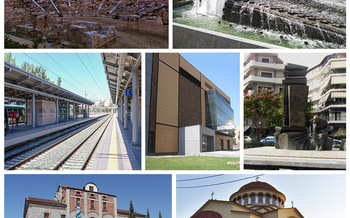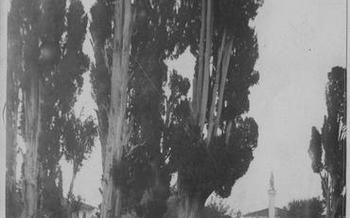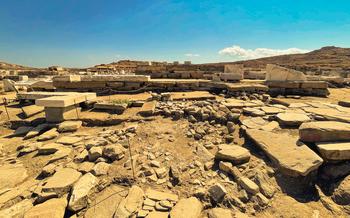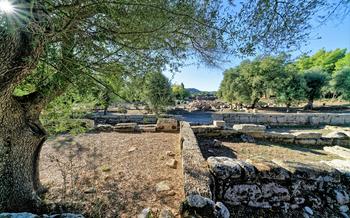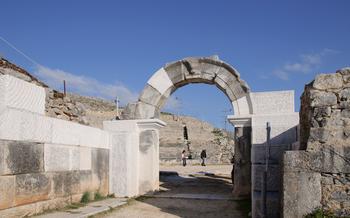
The Roman Bathhouse of Dion
- The Roman Bathhouse of Dion: A Historical Overview
- Tepidarium: The Warm Room
- Frigidarium: The Cold Room
- Apodyterium: The Changing Room
- Uncovering the Mosaics: A Visual Delight
- The Healing Power of Water: A Sanctuary for Well-being
- Dion Archaeological Museum: A Treasure Trove of Discoveries
- Getting There: A Journey to the Past
- Hours of Operation and Admission Fees: Practical Information
- A Stroll Through History: Exploring Dion's Ancient Ruins
- Beyond Dion: Discovering the Region's Charms
The Roman Bathhouse of Dion: A Historical Overview
In the heart of ancient Greece, nestled amidst the ruins of the city of Dion, lies a testament to the grandeur and sophistication of Roman civilization—the Roman Bathhouse of Dion. Constructed during the 2nd century CE, the bathhouse served as a sanctuary for relaxation, rejuvenation, and socialization for the city's inhabitants. This architectural masterpiece not only provided a place for bathing but also reflected the cultural and social significance of bathing in the Roman world.
The Roman Bathhouse of Dion was an integral part of the ancient city, catering to the needs of both citizens and visitors alike. Its strategic location near the city center and the sacred sanctuary of Zeus made it a popular destination for those seeking physical and spiritual well-being. The bathhouse's intricate design and luxurious amenities mirrored the opulence and extravagance of the Roman Empire, showcasing the engineering prowess and artistic sensibilities of its builders.
Step into this historical gem and embark on a journey through time, where the echoes of ancient laughter and whispers of forgotten conversations still linger in the air. Discover the secrets of this architectural marvel, immerse yourself in the bathing rituals of the past, and marvel at the intricate mosaics that adorn its walls and floors. The Roman Bathhouse of Dion stands as a testament to the enduring legacy of the Roman Empire, inviting you to delve into a world where history, culture, and architecture intertwine.
Tepidarium: The Warm Room
The tepidarium served as a transitional space between the hot and cold rooms, allowing bathers to gradually adjust their bodies to the varying temperatures. This intermediate chamber played a crucial role in the bathing ritual, preparing the body for the invigorating plunge into the frigidarium.
The tepidarium was typically maintained at a moderate temperature, providing a gentle transition from the intense heat of the caldarium. This gradual cooling process helped prevent sudden shocks to the system, ensuring a more comfortable and enjoyable bathing experience.
Design-wise, the tepidarium often featured benches or seating areas where bathers could relax and acclimatize to the changing temperatures. The room's atmosphere was likely less humid compared to the caldarium, creating a more pleasant and breathable environment.
By easing the transition between hot and cold, the tepidarium played a vital role in the overall bathing experience, promoting both physical and mental well-being.
Frigidarium: The Cold Room
The frigidarium, the final stop in the bathing circuit, held immense significance in the Roman bathing ritual. It served as a place of refreshing contrast and invigorating immersion after the intense heat of the caldarium and the gradual cooling of the tepidarium. The frigidarium typically featured plunge pools filled with cold water, allowing bathers to submerge themselves and experience the bracing effects of the icy plunge.
The cold-water immersion served several purposes. Firstly, it aided in closing the pores of the skin, which had been opened up by the heat of the previous rooms. This helped to seal in the benefits of the bathing process and restore the body's natural balance. Secondly, the cold water stimulated blood circulation, promoting overall well-being and vitality. The frigidarium offered a refreshing and invigorating conclusion to the bathing experience, leaving bathers feeling revitalized, rejuvenated, and ready to face the day ahead.
Apodyterium: The Changing Room
The apodyterium, or changing room, was a crucial part of the Roman bathing experience. It served as a space for bathers to prepare for their immersion in the various chambers. Situated adjacent to the entrance, the apodyterium featured a practical layout, with seating areas and storage facilities for clothing and personal belongings.
Here, bathers would shed their garments and don appropriate attire for their bathing session. The changing room provided a private and convenient space for them to transition between their everyday clothes and the bathing garments.
The apodyterium's design often reflected the overall grandeur of the bathhouse. In some cases, it was adorned with intricate mosaics and frescoes, creating an aesthetically pleasing environment for bathers to prepare for their ritual.
Uncovering the Mosaics: A Visual Delight
Adorned with intricate mosaic floors, the Roman Bathhouse of Dion stands as a testament to the artistry and craftsmanship of the ancient world. These exquisite mosaics are not merely decorative elements; they offer a glimpse into the lives, beliefs, and cultural influences that shaped this ancient city.
Skillfully crafted by Roman artisans, the mosaics depict a range of subjects, from mythological scenes to everyday life. Visitors can admire the vibrant colors and detailed representations of gods, heroes, and ordinary people engaged in various activities. The mythological scenes often draw inspiration from Greek and Roman mythology, providing a glimpse into the religious beliefs and storytelling traditions of the time.
Beyond their artistic value, the mosaics also offer insights into the daily lives of the people who frequented the bathhouse. Depictions of bathers, athletes, and musicians provide a vivid portrayal of the social and recreational activities that took place within these walls. The mosaics not only enhance the visual appeal of the bathhouse but also serve as a valuable source of historical information.
As you explore the different sections of the bathhouse, keep an eye out for these stunning mosaics. They are scattered throughout the complex, adorning the floors of the caldarium, tepidarium, frigidarium, and other areas. Each mosaic tells a unique story, adding to the overall narrative of this remarkable ancient site.
The Healing Power of Water: A Sanctuary for Well-being
The Roman Bathhouse of Dion was not merely a place for cleansing and hygiene; it was also a sanctuary dedicated to well-being and rejuvenation. The ancient Romans believed in the therapeutic powers of water, and the bathhouse was designed to provide a holistic experience that addressed both physical and mental well-being.
The warm, soothing waters of the caldarium and tepidarium were known to alleviate muscle tension, improve circulation, and promote relaxation. The contrast between the hot and cold baths stimulated the immune system and invigorated the body, leaving bathers feeling refreshed and revitalized.
Beyond its physical benefits, bathing in the Roman Bathhouse was also a social and cultural activity. It was a place where people could gather, socialize, and share stories while immersing themselves in the restorative powers of water. The bathhouse was a sanctuary where individuals could escape the stresses of daily life and find solace and tranquility.
The pursuit of physical and mental well-being was an integral part of Roman culture, and the bathhouse played a central role in this pursuit. It was a place where people could come together to cleanse their bodies, soothe their minds, and restore their spirits.
Dion Archaeological Museum: A Treasure Trove of Discoveries
The Dion Archaeological Museum stands as a testament to the rich history and cultural heritage of ancient Dion. Within its walls, a treasure trove of artifacts and exhibits from the Roman Bathhouse and other significant sites in the region awaits eager visitors. These relics provide a fascinating glimpse into the daily life and customs of the ancient Dionians, shedding light on their religious beliefs, artistic expressions, and technological advancements.
Among the museum's highlights are intricate mosaics that once adorned the floors of the bathhouse, depicting scenes from mythology and everyday life. These vibrant artworks offer a glimpse into the artistry and craftsmanship of Roman artisans. Other notable exhibits include sculptures, pottery, coins, and inscriptions that tell the story of Dion's illustrious past.
A visit to the Dion Archaeological Museum is an essential complement to exploring the Roman Bathhouse. It enriches the experience by providing a deeper understanding of the ancient city and its people. Through these artifacts, visitors can connect with the lives and traditions of those who walked these lands centuries ago.
Getting There: A Journey to the Past
Nestled in the heart of Dion, the Roman Bathhouse stands as a testament to the city's rich past. Reaching this ancient treasure is a journey in itself, transporting you back in time as you traverse the picturesque landscapes of Pieria.
To immerse yourself in the wonders of the Roman Bathhouse, you can conveniently arrive by public transportation or embark on a scenic drive in your private vehicle. Dion is well-connected by buses from major cities in Greece, making it easily accessible for travelers.
Once you arrive in Dion, the path to the Roman Bathhouse is clearly marked, guiding you through the charming streets of this ancient city. As you approach the site, the imposing ruins of the bathhouse emerge, beckoning you to step into a world of history and wellness.
For a truly memorable experience, consider exploring the surrounding area as well. The ancient city of Dion is a treasure trove of archaeological wonders, including the Temple of Zeus and the Sanctuary of Demeter. These sites offer a glimpse into the religious and cultural practices of ancient Greece, providing a comprehensive understanding of Dion's rich heritage.
Hours of Operation and Admission Fees: Practical Information
The Roman Bathhouse of Dion is open to the public daily, except for Mondays. Visitors can explore the ancient site from 8:00 am to 3:00 pm. Admission fees are affordable, making it accessible to travelers of all budgets. A standard ticket for adults costs [Amount], while reduced rates are available for students, seniors, and children. There are also family tickets and group discounts for those exploring the bathhouse with friends or family. Remember to carry your valid ID or student card to avail discounts. The ticket office is located at the entrance of the archaeological site, where you can purchase tickets and obtain any necessary information.
A Stroll Through History: Exploring Dion's Ancient Ruins
Dion's ancient ruins offer a captivating glimpse into the city's rich past. Beyond the Roman Bathhouse, visitors can embark on a journey through time, discovering other significant historical sites that tell the story of this ancient metropolis.
One of the most impressive landmarks is the Temple of Zeus, a majestic sanctuary dedicated to the king of the gods. Its towering columns and intricate carvings stand as a testament to the architectural prowess of the ancient Greeks. Visitors can wander among the ruins, imagining the grandeur of religious ceremonies and festivals that once took place within these sacred walls.
Another must-see attraction is the Sanctuary of Demeter, a sprawling complex dedicated to the goddess of agriculture and fertility. Here, visitors can explore the remains of temples, altars, and other structures that once formed the heart of Dion's religious and cultural life. The well-preserved mosaics and sculptures provide a glimpse into the beliefs and practices of the ancient inhabitants.
Strolling through the ancient ruins of Dion is a journey through time, allowing visitors to connect with the spirit of this once-thriving city. From the grandeur of the Temple of Zeus to the sacredness of the Sanctuary of Demeter, each site offers a unique perspective on the city's rich history and cultural heritage.
Beyond Dion: Discovering the Region's Charms
Dion's allure extends beyond the confines of its ancient ruins. The region beckons travelers with a myriad of attractions that showcase its natural beauty and cultural heritage.
A short drive from Dion lies Mount Olympus, the mythical home of the Greek gods. Towering over the landscape, this majestic mountain offers breathtaking views and a sanctuary for nature enthusiasts. Explore its verdant slopes, ascend to its snow-capped peaks, and immerse yourself in the legends that have captivated generations.
Adjacent to Mount Olympus lies the picturesque Olympus National Park, a treasure trove of natural wonders. Discover pristine forests, cascading waterfalls, and diverse wildlife within this protected paradise. Embark on invigorating hikes, encounter rare flora and fauna, and revel in the tranquility of this unspoiled wilderness.
For those seeking coastal adventures, the Pieria region boasts an array of enchanting beaches. Bask in the golden sunshine, plunge into the crystal-clear waters of the Aegean Sea, and create lasting memories along the stunning coastline. Discover secluded coves, enjoy water sports, or simply relax and soak up the Mediterranean vibes.
